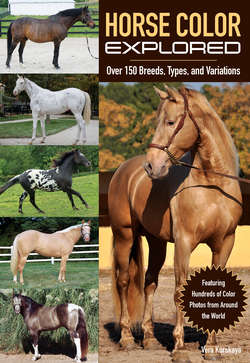Читать книгу Horse Economics - Vera Kurskaya - Страница 27
На сайте Литреса книга снята с продажи.
COLORS DETERMINED BY CREAM DILUTION Buckskin
ОглавлениеA buckskin is a bay horse with one Cream Dilution allele (Ccr). Buckskin horses have a sandy yellow color of trunk, neck, and head, while the mane, tail, and lower parts of the legs are black (Photo 17). The nuances of body color are broad—from pale yellow or almost white to dark yellow. The lower part of the legs sometimes appears brown rather than black. The skin is pigmented but can be somewhat lighter than in a bay horse; the eyes are hazel or amber. Dapples are frequently observed.
I distinguish three varieties of the color, depending on the bay base: light buckskin, average buckskin, and dark buckskin. Light buckskin horses are characterized by sandy, sometimes almost white coloring of body. Average buckskin horses have a standard yellow body color, and as a rule, dark buckskins can have a significant amount of dark hair, concentrated on the upper back (countershading) in contrast to the lighter abdomen (Photos 18 & 19). The parts closer to the darker area tend to show dapples.
Newborn buckskin foals are typically light in color, tending to darken after they shed their baby hair. The lower part of the legs can be diluted or black, and with time the black zone tends to extend almost to the knees and elbows.
This color is encountered in many breeds: Lusitanos, Quarter Horses, Miniature Horses, Shetland Ponies, Welsh Ponies, Connemara Ponies, Australian Ponies, and Kinsky horses, for example. Light or dark buckskin color (with visible countershading) is common in the Akhal-Teke breed, and the Byelorussian Harness Horse frequently features very light-colored horses with an almost white trunk. Very rarely is the buckskin color found in Orlov Trotters, and only very recently was it discovered in Thoroughbreds.
